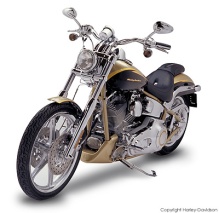The True Measure of Lubricant Quality
By Ed Newman
This article appeared in Power Stroke Registry, Summer Edition 2003
Making and recording measurements has been one of the hallmarks of the Age of Enlightenment. It seems like modern people measure everything. We have measures of time, such as weeks, hours, minutes, and years. We have measures of mass, such as grams, pounds and tons. We have measures of sound volume, of energy, of radioactivity, of pressure, of sizes, of land mass, and of speed.
Automotive Related Measurements
Horsepower, as you might guess, is the amount of power exerted by one horse pulling. After many careful
measurements James Watt, inventor of the steam engine, determined that a horse can lift 550 pounds at a rate of
one foot per second, which translates into 745.7 watts. Some clever American engineers decided that manpower
should have a measurement as well, equivalent to 0.1 horsepower or 74.57 watts.
MPG is the familiar acronym for miles per gallon, which measures the rate of fuel consumption in a motor vehicle.
One mile per gallon equals approximately 0.4252 kilometers per liter. MPH is our common measure of speed. One
mile per hour equals 22/15ths feet per second or 1.609 kilometers per hour or 0.447 meters per second.
RPM means revolutions per minute, a unit of frequency as a measure of rotation rates in mechanics. In cars RPM is
measured by a tachomoter. Some motorists pay attention to RPM so they don't overrev and cause component failure.
Race car drivers try to keep RPM rates in a range that will provide maximum power.
Oil Measures
A quart as a unit of volume is so named because it represents one quarter of a gallon. When measuring liquid,
one quart is 32 fluid ounces, or 57.75 cubic inches. On the other hand, when measuring dry goods like pecans or
blueberries, a quart is 67.201 cubic inches. Go figure.
Drums are sometimes used for measuring oil, containing 55 U.S. gallons or about 208.198 liters. Drums are not the
same as barrels, the standard unit of volume for measuring crude. One drum is equivalent to 1.3095 barrels. A
barrel is equivalent to 42 U.S. gallons, which is coincidentally the same size as a traditional wine barrel, more
commonly called a tierce.
But what about oil quality? What are the criteria that are important when measuring the performance quality of a
motor oil?
Part of the answer comes from understanding the role that motor oils play when it comes to engine lubrication.
Another part of the answer comes from understanding that we live in a scientific age in which nearly everything
can be, and often has been, measured. Knowing what to measure and how to measure it is an important part of good
decision making. We're talking motor oil here.
The Role of a Motor Oil
Before we can discuss what makes a good motor oil, it helps to understand what role motor oil actually plays in
the performance of an engine.
While motor oils serve a variety of functions, they are primarily necessary to lubricate and to cool the engine.
When the engine is at rest, the motor oil sits in the bottom of the engine block in what is called the oil pan.
Upon start-up, an oil pump feeds oil from the pan to the oil distribution system by means of a network of
passages, tubes, grooves and holes leading to the engine bearings and other surfaces needing pressurized oil for
lubrication. Other parts, like the overhead valve system, receive a carefully controlled quantity of
non-pressurized oil through splashing or spray.
In addition to lubricating and cooling engine parts, motor oil must allow easy starting, protect the engine from
corrosion and oxidation, keep the engine clean, form a tight seal between piston rings and cylinder walls and
help the engine use fuel efficiently.
In days gone by motor oil was made from the throwaway byproducts of a barrel of crude oil after everything useful
was taken from it. In those early days the filter, if you had one at all, was a by-pass type, filtering only a
small percentage of the oil. In some instance the filter was little more than a screen and the oil was changed
every five hundred or thousand miles. (Some of us recall grandpa's stories of tires needing to be changed on
every trip to town, the idea of longevity being somewhat foreign back then.)
As cars and their engines became more sophisticated, so too the requirements of a lubricant became increasingly
demanding. In the 1960's jet fighter pilots and their mechanics were becoming aware of the advantages of
synthetic oils, and a few of them experimented with the notion of synthetic lubrication for automobiles. One of
these pilots, Lt. Colonel Albert J. Amatuzio, went further than the haphazard experiments of his peers. His ten
year quest resulted in the development of AMSOIL, the first automotive synthetic motor oil to exceed the
certification requirements of the American Petroleum Institute (API).
Synthetic vs. Conventional Petroleum
Conventional lubricants are refined from crude oil which has thousands of types of molecules. Refining is a
process of physically separating the impurities from the oil and further separating the light and heavy
components. Because refining separates products by weight, it groups molecules of similar weight and dissimilar
structure. The result is a lubricant with a wide assortment of molecules. Some of the substances in crude oil are
detrimental to lubrication. Paraffins, for example, are a common conventional oil contaminant that causes motor
oil to thicken in cold temperatures.
Synthetic motor oils are made from pure chemicals, not refined crude. Their components are chemically reacted to
produce finished products with pre-designed performance characteristics. Because of their molecular uniformity,
they excel in reducing friction, which improves fuel efficiency, controls heat and reduces wear. This molecular
uniformity also helps synthetics resist thinning in hot temperatures and thickening in cold.
Measures That Matter
The American Society for Testing and Materials recognized the need for uniform procedures that can be
duplicated and verified by laboratories in any location. The goal of establishing standards is so important that
the official publication of ASTM International is called Standardization News.
Founded in 1898 and completely voluntary, ASTM is now one of the largest non-profit standards development systems
in the world. The organization currently has 134 committees that write standardized test methods for materials,
products, systems and services. More than 8500 ASTM specifications have been established for products as diverse
as metal, paints, plastics, textiles, energy, consumer products, medical services and instruments and even the
environment.
Developing standard measurement methods is part of the task of ASTM. Equally important is determining what
measures are important, tests that actually correspond to what the function of motor oil is intended to fulfill.
What follows here are some tests commonly used to evaluate motor oil performance.
ASTM D-445 Kinematic Viscosity
The proper operation of equipment depends on the proper kinematic viscosity of the oil at operating temperatures. Kinematic viscosity is a measure of a liquid's flow under the influence of gravity. Some companies formulate their lubes to tighter specs than others. One recent study revealed that one in five off-the-shelf motor oils tested were outside the acceptable performance range for their stated viscosities.
ASTM D-2270 Viscosity Index
This test indicates how much a lube's viscosity will change according to changes in temperature from 40°C and 100°C. The higher the viscosity index the better for motor oils that must perform in locations with temperature variations.
ASTM D-5293 Cold Crank Simulator Apparent Viscosity
Cold crank viscosity affects the startability of engines in cold temperatures. Low cold cranking viscosities make for easier cold cranking and more dependable cold temperature starting, and less drain on batteries.
ASTM D-3829 Borderline Pumping Temperature
This test is used to predict the lowest temperature at which a motor oil can be continuously and adequately supplied to an engine's components. As the name suggests, the lower the temperature, the better the oil circulates in cold weather. Synthetic oils are famed for the extreme low temperature protection.
ASTM D-97 Pour Point
This test identifies the lowest temperature at which oil flows.
ASTM D-92 Flash Point and Fire Point
Flash point indicates the temperature at which a specimen vapors will ignite. Flash point assesses the overall hazard of a material and is used in shipping and safety regulations to define "flammable" and "combustible" materials. Fire point measures the temperature at which a specimen will remain burning for five seconds. Synthetic lubricants with high flash and fire points are safer to use and transport than petroleum lubes with lower ones. High flash point is indicative of a greater high temperature operating range and better quality base stock.
ASTM D-4683 High Temp, High Shear Viscosity
This test is representative of the conditions encountered in the bearings of automotive engines in severe service. Lubricants with high scores, such as premium synthetics, maintain their viscosity in high temperatures after exposure to high shear. This means that they continue to protect bearings even after exposure to severe service conditions.
ASTM D-892 Foaming Tendency
This test is important because of the turbulent environment in which motor oils are required to perform. Foaming can lead to inadequate lubrication, cavitation and mechanical failure.
ASTM D-4172B Four Ball Wear Test
The Four Ball Wear Test determines the relative wear prevention properties of lubricants in sliding contact. The test involves three fixed balls in a bath of lubricant with a fourth ball in rolling contact under pressure at a specific level of severity. Wear protection is gauged by measuring the wear scar that develops. A smaller wear scar means better protection in typical engine operations.
ASTM D-5800 Noack Volatility
Oil volatility is the measure of how susceptible oil is to boil-off under high heat conditions. Petroleum oils experience significant boil-off during high temperature engine operation and subsequently higher oil consumption. Evaporation loss contributes to damaging deposits, sticky piston rings and oil blow-by, resulting in a drag on performance and reduced engine life. Synthetic oils are far more impervious to this kind of degradation. The lower volatility of synthetics is another reason they are also better for the environment than conventional products.
SAE J1321 Joint TMC/SAE Fuel Consumption Test Procedure - Type II
The Society of Automotive Engineers has devised a test to measure fuel consumption and fuel economy. In a
demonstration involving over-the-road trucks an improvement of 8.2% was achieved by switching from conventional
lubes to synthetic lubricants (in this case AMSOIL products) in the drivetrain and engine.
Here's an interesting, undisputed fact. By every one of these measures premium synthetic motor oils are superior
to conventional petroleum motor oils. This truth is never even questioned by industry professionals.
So why, one might ask, isn't everyone using synthetic motor oils and lubes? Here's one possible reason. To divert
attention away from the performance measures above the major oil companies focus on one other measure: price.
Price
Ironically, we live in an era in which people are spending more money than ever on large vehicles or cool
looking vehicles - PT Cruisers, SUVs, Hummers, and dualies. Insurance payments alone in most households run ten
times greater than motor oil costs. People are passionate about their vehicles. How can they not be equally
dedicated to protecting their investment by using premium lubricants that promise longer life to the object of
their passion. You wouldn't expect price to be that big of a deal, yet it is for some people. For this reason the
price myth must be addressed.
When people talk about price, they generally think in terms of initial cost instead of life cycle cost. Price is
only an issue if you apply the 3,000 mile oil change rule to all motor oils alike. In truth, the service life of
synthetics can be extended much longer due to their resistance to oxidation and other forms of degradation. With
proper filtration engine oil can be safely used for much longer periods, and is thereby less costly than
petroleum in the long run. Add to this the reduced fuel consumption, fewer maintenance bills and optimal
performance characteristics and running anything but a premium synthetic motor oil should not even be a
consideration.
Closing Thoughts
As you can readily see there is no single measure that stands alone as the signature of superior performance. A motor oil serves a variety of functions in a range of roles inside the engine. What tests do show is that synthetic motor oils as a class are far and away superior to petroleum based products.
We're now on Facebook!

Buy at wholesale price!
Preferred Customers buy at dealer cost and save 25%!

Not sure which products to get for your vehicle? Use the Vehicle Lookup Guide.

AMSOIL Distributor Opportunities
Start your own home business based on a proven superior product. Very low startup costs.

Sell AMSOIL products in your shop or store. Click here for information on AMSOIL retail accounts.

Does your business purchase lubricants for its equipment? Click for information about AMSOIL commercial accounts! Extend your equipment's life and reduce costs!
